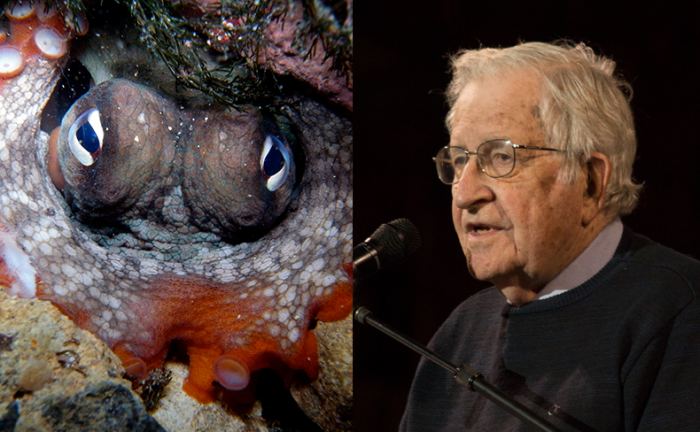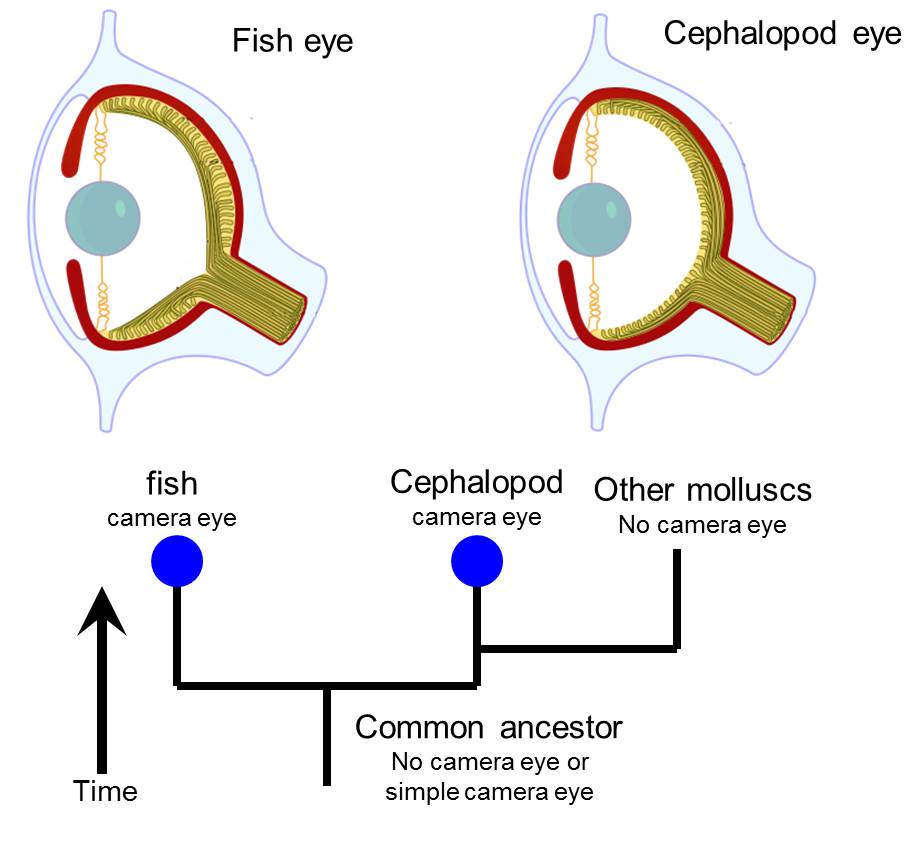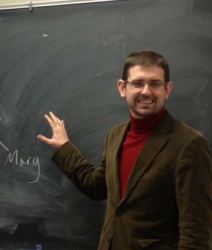Cosmic language, part 1: is universal grammar universal?
- Transfer

The eyes of the octopus demonstrate the phenomenon of convergent evolution - a hint at the possibility that the structure of the language of aliens may be similar to ours.
METI Symposium
Symposium
How would you make a message for sentient beings from another planet? They would not be familiar with any of the languages of mankind. Their “speech” may differ from ours in the same way as the eerie screams of whales or the flickering lights of fireflies. Their cultural and scientific history would have their own way. Even their minds can work differently from ours. Will the deep structure of the language, the so-called " universal grammar"are aliens the same as ours? A group of linguists and other scientists gathered on May 26, 2018 to discuss the complex problems of developing a message that extraterrestrial beings could understand. There are more and more hopes that among the billions of inhabited planets that as we now believe exist in our galaxy, there will be such creatures. This symposium, called Language in the Cosmos, was organized by the METI International initiative . It was held as part of the International Conference on the Development of Space in Los Angeles , organized Called National Space Society by Dr. Sherry Wells-Jensen, a linguist at Bowling Green State , Ohio.
What is METI International?
"METI" means "messages to extraterrestrial civilizations" (Messaging to Extra-Terrestrial Intelligence). METI International is an organization of scientists and researchers who are trying to promote a completely new approach to the search for alien civilizations. Since 1960, researchers have been searching for aliens, searching for possible messages that they could send us via radio or laser beams. They were looking for megastructures that advanced alien societies could build in space. METI International wants to go beyond this completely passive search strategy. The organization wants to compose and transmit messages to the planets relatively close to our stars, hoping to get an answer.
One of the main goals of the organization is the creation of an interdisciplinary community of researchers engaged in the development of interstellar communications that the inhuman mind could understand. The overall goal of the organization is to promote research in the search for extraterrestrial intelligence and astrobiology, and an attempt to understand the evolution of intelligence that took place here on Earth. The symposium, which lasted all day, fit eleven presentations. Their main topic was the role of linguistics in communication with extraterrestrial intelligence.

This article
This article is the first of two articles in the series. It concentrates on one of the most fundamental issues discussed at the conference. It is a question of whether it can turn out that the structure underlying the language of aliens will be the same as ours. Linguists understand the deep structure of the language with the help of the theory of "universal grammar". Prominent linguist Noam Chomsky developed this theory in the middle of the twentieth century.
Two interrelated presentations of the symposium addressed the problem of universal grammar. The first was done by Dr. Jeffrey Pansky of the University of Southern Illinois, and Dr. Bridget Samuels of the University of Southern California. Dr. Jeffrey Watamullfrom Oceanit, co-sponsored by Dr. Ian Roberts of the University of Cambridge, and Dr. Noam Chomsky himself from the Massachusetts Institute of Technology.
Is Chomsky's universal grammar suitable only for people?
Universal Grammar
Despite the name of this theory, Chomsky originally built his theory of “universal grammar” to show the existence of serious, and possibly insurmountable barriers to understanding when people and aliens communicate. First, let's look at why it seems that Chomsky's theories make interstellar communication almost hopeless. And then we will see why Chomsky’s colleagues who spoke at the symposium, and Chomsky himself, now think differently.
Before the second half of the 20th century, linguists believed that at first the human brain imagines a clean sheet, and we study languages exclusively through experience. These views came from the XVII century philosopher John Locke , and were developed in the laboratories of behavioral psychologists.the beginning of XX century. Since the 1950s, Noam Chomsky has challenged these views. He argued that language learning cannot be a simple process of linking stimuli with responses. He observed how small children, even up to 5 years old, can confidently create and interpret new sentences that they had not previously heard. He spoke of the "paucity of incentives." Children could never have come across enough examples of using a language to learn its rules from scratch.
Instead, Chomsky suggested that there is a “language organ” in the human brain. At birth, this body is already tuned to the basic rules of the language, which it called the "universal grammar." It provides initial training for babies to learn any language they encounter using a limited number of examples. He suggested that the language organ emerged in the course of human evolution, perhaps even just 50,000 years ago. Chomsky's convincing arguments were accepted by other linguists. He was considered one of the greatest linguists and cognitiveists of the 20th century.
Universal grammar and "Martians"
People speak over 6000 different languages. Chomsky defined his “universal grammar” as “a system of principles, conditions and rules that are elements or properties of all human languages”. He said that through it “the essence of human language” can be expressed. But he was not convinced that “the essence of human language” was the essence of all theoretically possible languages. When Chomsky was asked in an interview with the magazine Omni Magazine in 1983 whether he considers it possible for people to learn the language of aliens, he replied:
“Unless their language violates the principles of our universal grammar, which, given the huge number of ways in which languages can be organized, it seems to me very likely. The same structures that allow us to study human languages do not allow us to study languages that violate the principles of universal grammar. If the Martians had landed here, flying from deep space, and started talking in a language that violates the universal grammar, we simply would not look to learn this language as we learn human languages, such as English or Swahili. We would have to slowly and with great difficulty approach the language of aliens - just as scientists study physics, in which the work of several generations of people is required to acquire new knowledge and meaningful progress. We are nature adapted for English, Chinese and any other possible human language. But we are not fit to learn completely normal languages that violate the principles of universal grammar. These languages will remain beyond our capabilities. ”
Chomsky knew that if there is an intelligent life on another planet that uses language, it definitely appeared as a result of a set of evolutionary changes that is different from the uniquely unlikely path that gave rise to human beings. A different history of climate change, geological events, impacts of asteroids and comets, random genetic mutations and other events, would have produced a different set of life forms. They would interact with each other during the existence of life on the planet in other ways. The “Martian” language organ, with its excellent and unique history, could, as Chomsky suggested, be completely different from the human counterpart, which would make communication monumentally difficult, if not impossible at all.
Convergent Evolution and Aliens Minds
Tree of life
Why did Chomsky think that the language organs of people and "Martians" would most likely turn out to be fundamentally different? Why now he and his colleagues think differently? To find out, we first need to learn the basic principles of evolutionary theory.
The theory of evolution, originally formulated by the naturalist Charles Darwin in the 19th century, is the central principle of modern biology. This is our best tool for predicting how life might look on other planets. The theory states that living beings evolve from the creatures that preceded them. She suggests that all life on Earth originated from the original earthly form of life that existed more than 3.8 billion years ago.
These relationships can be thought of as a tree with many branches. The base of the tree trunk represents the first form of life on Earth, 3.8 billion years ago. The end of each branch represents the present, modern species. The diverging branches connecting the ends of the branches with the trunk represent the evolutionary history of each species. Each branch point represents the time at which the two species diverged from a common ancestor.
Evolution, Brain and Chance
To understand the way Chomsky thinks, we start with a familiar group of animals - vertebrates. This group includes fish, amphibians, reptiles, birds and mammals, including humans.
We compare the vertebrates with their less familiar, distant group; cephalopods . This group includes octopuses, squid and cuttlefish. These two groups evolved in different ways - along different branches of our tree - over 600 million years. I chose them precisely because, on the way along their branches of the evolutionary tree, they independently developed their own variants of complex brains and sense organs.
The brains of all vertebrates are arranged according to one basic plan. The reason for this is the evolution from a common ancestor who already had a brain arranged according to this plan. The brain of the octopus is organized completely differently. The common ancestor of cephalopods and vertebrates is much farther in time, on the lower branch of the evolutionary tree. He probably had the simplest brain, if there ever was.
Without a general plan that can be inherited, the two types of brain evolved independently of each other. They differ because evolutionary changes are random. They are influenced by various combinations of factors, including the case. These unforeseen influences along the path of the development of the cephalopod brain and the vertebrate brain were different.
Chomsky believed it was theoretically possible for a multitude of languages to exist that seemed to violate the seemingly random restrictions that exist in a universal human grammar. It seemed that nothing existed that would make our universal grammar special. Therefore, due to the random nature of evolution, Chomsky suggested that the "Martian" language organ would choose one of these possibilities, which would make it fundamentally different from the human counterpart.
This kind of evolutionary pessimism about the likelihood that humans and aliens will be able to communicate with each other is widespread. At the symposium, Dr. Gonzalo Munevar of Lawrence University of Technology argued that sentient beings who as a result of evolution had senses and cognitive structures different from ours would not be able to develop similar scientific theories or even similar mathematics.
Evolution, eyes and convergence
Let's look at another feature of the octopus and other cephalopods - their eyes. Surprisingly, the eyes of octopuses echo the organs of vision in vertebrates in the smallest detail. This strange similarity cannot be explained in the same way as the similarity of the brains of vertebrates. It almost certainly failed as a result of inheritance from a common ancestor. Some genes that are responsible for the structure of the eyes are really the same in most animals , and they appeared once very long ago, in the distant parts of the trunk of the tree of evolution. But biologists are almost certain that the common ancestor of cephalopods and vertebrates was too simple to even have eyes.
Biologists believe that the eyes appeared as a result of evolution on different branches of the tree of life independently of each other more than forty times. There are many different eyes. Some of them are so different from ours that they would surprise even a science fiction writer. Therefore, if evolutionary changes are random, why are octopus eyes so much like ours in such detail? The answer lies outside the theory of evolution, in the field of the laws of optics. Many large animals, including octopuses, require acute vision. According to the laws of optics, there is only one suitable way to satisfy these needs. When such an eye is required, evolution finds the same best solution. This phenomenon is called convergent evolution .
Life on another planet should have its own tree of evolution, the base of the trunk of which means the emergence of life on this planet. Due to the randomness of evolutionary changes, the pattern of branches can be very different from the earth tree. But since the laws of optics are the same throughout the Universe, it can be expected that large animals will have eyes under similar conditions, very similar to the eyes of vertebrates or cephalopods. Convergent evolution is a potentially universal phenomenon.

The eye of the fish (left), the aquatic vertebrate, and the eye of the cephalopod mollusk (right) are almost identical, but evolved independently. This surprising similarity exists due to convergent evolution. The common ancestor of fish and cephalopod mollusks did not have well-developed eyes, nor do they have mollusks that are not cephalopods. This structure of the eye is like a camera; there is a lens in front of the eye, and a photosensitive retina in the back.
Now not only for people?
We understand the language authority

Jeffrey Pansky
the beginning of the XXI century, Chomsky and some of his colleagues began to look differently on the body language and universal grammar. Within the framework of the new view, it seems that the properties of the universal grammar are inevitable, as the properties of optics make the inevitable appearance of many properties in the octopus eye.
In a 2002 survey, Chomsky and his colleagues, Mark Hauser and Tecumseh Fitch, argue that the language organ can be decomposed into several separate parts. The sensory-motor, or externalization system is responsible for the mechanics of expressing a language by methods such as verbal speech, writing, typing, or sign language. A conceptually-conscious system associates language with concepts.

Bridget Samuels
The core of the system, according to the assumption of linguists, consists of what they call the highly specialized language module (UML) [ language faculty ]. This is a system of recursive application of the rules of the language, allowing you to create almost infinite series of meaningful expressions. Jeffrey Pansky and Bridget Samuels also talked about the "syntactic spine" of all human languages. Syntax is a set of rules that govern the grammatical structure of sentences.
The inevitability of universal grammar
Chomsky and his colleagues carefully analyzed the calculations that the nervous system must perform to work with such recursion. For an abstract description of the UML work, the researchers took a mathematical model such as a Turing machine . Mathematician Alan Turing developed this model at the beginning of the 20th century. His theoretical machine led to the development of electronic computers.
Their analysis led them to an unexpected and surprising conclusion. In the book, which is currently in print, Watamull and Chomsky write: “Recent work demonstrating the simplicity and optimality of languages reinforces the hypothesis that could once have been rejected because of absurdity: the basic principles of language stem from the area of conceptual necessity.” Jeffrey Watamull wrote that this strong minimalist thesis asserts that "there are limitations in the structure of the universe itself, which all systems cannot ignore." Our universal grammar is something special, and not one of many theoretically possible options. "

Ian Roberts
Plateau and thesis of strong minimalism
The constraints of mathematical and computational necessity form the UML as it is, just as the laws of optics form the eyes of vertebrates and cephalopods. “Martian” languages in this case can follow the rules of the same universal grammar as human languages, since there is only one optimal type of recursive core of a linguistic organ.
Due to convergent evolution, nature will be obliged to find this unique, best way when and where language evolves in it. Whamullus suggested that the mechanisms of brain arithmetic may reflect a similar inevitable convergence. This means that the basics of arithmetic will be the same for humans and aliens. We are obliged, write Whamull and Chomsky, "to rethink all the assumptions that extraterrestrial intelligence or artificial intelligence may differ so much from human intelligence."
This is an astounding conclusion presented at the Watamull Symposium with the help of Pansky and Samuels. Universal grammar can be truly universal. Whamullus compared this thesis with the modern version of the conviction of the ancient Greek philosopher Plato, which appeared in the era of computers, who believed that mathematical and logical relationships are real things that exist in a separate world that the human mind simply discovers. These ideas, bringing something new to a complex and very old philosophical problem, will no doubt cause debate. They illustrate the depth of new knowledge awaiting us on other worlds and in other minds.

The ancient Greek philosopher Plato in the representation of the artist of the Renaissance, Raphael. Plato believed that mathematical and logical truths objectively exist, that they are not connected with our mind, but are simply discovered by people. Jeffrey Watamull, Ian Roberts and Noam Chomsky describe the idea of UML, which is a modern version of Plato's views, in which the necessary mathematical, logical and computational interrelations define the structure of UML and universal grammar. Since the exact same necessary interrelationships would influence the evolution of UMLs from aliens, they believe that alien languages would most likely have the same universal grammar as human languages.
Universal grammar and message for aliens
What are the implications of this new way of thinking about the structure of the language for practical attempts to create interstellar messages? Whamull thinks that this new approach challenges the "pessimistic relativism of those who consider it most likely that the earth (human) mind and the alien mind will (perhaps, in principle) be incomprehensible to each other." Pansky and Samuels agree and add that "mathematics and physics are likely to be the best choice in the search for common concepts that can be used as a starting point."
Whamullus suggests that, although alien or AI minds may be qualitatively similar to ours, they may differ quantitatively, have an increased amount compared to our memory or speed of thinking. He is sure that in the alien language there will most likely be nouns, verbs and sentences. This means that they are likely to be able to understand an artificial message containing similar objects. In his opinion, in his opinion, it would also be useful to include the structure and syntax of natural human languages, since these parameters are likely to be common with alien languages.
Pansky and Samuels are more cautious about ratings. They note: "Some linguists do not believe in the universality of nouns and verbs as categories of human languages." And yet they suspect that "alien languages will be built on the basis of individual meaningful units, which can be combined into larger meaningful units." Human speech consists of a linear sequence of words, but Pansky and Samuels note that "part of the linearity imposed on human language can flow from the limitations of our vocal anatomy, and it begins to fall apart as soon as we remember sign language."
In general, these discoveries give rise to a new hope that the development of a message understandable to aliens is a feasible task. In the next article we will look at a new example of such a message. In 2017, it was transmitted in the direction of a star located 12 light years from our Sun.
Links and additional materials
- Allman J. (2000) Evolving Brains, Scientific American Library
- Chomsky, N. (2017) The language capacity: Architecture and evolution, Psychonomics Bulletin Review, 24: 200-203.
- Gliedman J. (1983) Things no amount of learning can teach, Omni Magazine, chomsky.info
- Hauser, MD, Chomsky, N., and Fitch WT (2002) Did it evolve? Science, 298: 1569-1579.
- Land, MF and Nilsson, DE. (2002) Animal Eyes, Oxford Animal Biology Series
- Noam Chomsky's theories on language, Study.com
- Patton PE (2014) Communicating across the cosmos. Part 1: Bridging into the darkness, Part 2: Quest for the Rosetta Stone, Universe Today.
- Patton PE (2016) Alien Minds, I. Are extraterrestrial civilizations likely to evolve, II. Do you think big brains are sexy too? III. The Universe Today
